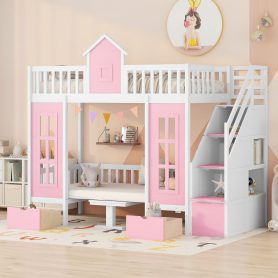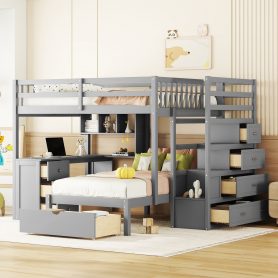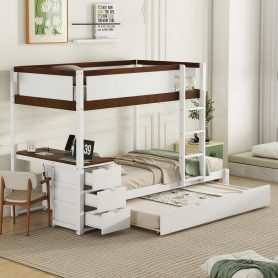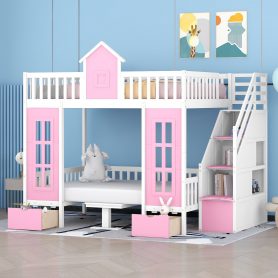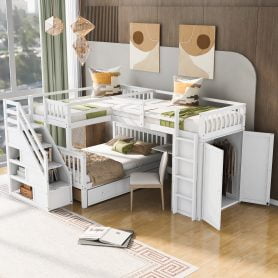
Introduction
Are you looking to maximize space in your child’s bedroom or create a functional workstation? A bunk bed with a desk underneath might be the perfect solution. Not only does it offer a comfortable sleeping arrangement, but it also provides a dedicated workspace for studying or creative activities.
In this article, we will guide you through the process of building a bunk bed with a desk underneath. Whether you are a skilled woodworker or a DIY enthusiast, we will provide step-by-step instructions and helpful tips to ensure a successful project.
Table of Contents
Why Choose a Bunk Bed with Desk Underneath?
A bunk bed with a desk underneath offers several advantages. Firstly, it saves valuable floor space, making it ideal for smaller bedrooms or shared spaces. By utilizing vertical space, you can create separate areas for sleeping and working without sacrificing functionality.
Additionally, a bunk bed with a desk underneath promotes productivity and organization. It provides a designated workspace where your child can focus on their schoolwork or hobbies. With built-in shelves or drawers, you can keep books, stationery, and other essentials within easy reach, minimizing distractions and enhancing productivity.
Materials and Tools
Before starting your project, gather the necessary materials and tools. The exact requirements may vary based on the design and specifications you choose, but here are some common items you will need:
- Wood planks or pre-cut bed frame kit
- Screws, nails, or dowels
- Wood glue
- Desk surface material (such as plywood)
- Drill
- Saw
- Screwdriver
- Measuring tape
- Sandpaper
- Paint or stain (optional)
Now that you have a basic understanding of why a bunk bed with a desk underneath is a practical choice and the materials and tools required, let’s dive into the step-by-step process of building one.
Benefits of a Bunk Bed with Desk Underneath
Having a bunk bed with a desk underneath can be a practical and space-saving solution for any bedroom. Not only does it provide a comfortable sleeping area, but it also offers a dedicated workspace for studying or working. Here are some of the key benefits of having a bunk bed with a desk underneath:
1. Maximizes Space
A bunk bed with a desk underneath is perfect for rooms with limited space. It allows you to make the most of the vertical space in the room, leaving more floor space available for other furniture or activities. This is especially beneficial in smaller bedrooms or shared rooms where space is at a premium.
2. Provides a Functional Workspace
Having a desk underneath the bunk bed creates a dedicated workspace that is separate from the rest of the room. This provides a quiet and focused environment for studying, working, or pursuing hobbies. The desk can accommodate a computer, books, and other study materials, making it a convenient and organized space for productivity.
3. Promotes Organization
A bunk bed with a desk underneath offers built-in storage options. Many designs feature shelves, drawers, or compartments where you can store books, stationery, and other essentials. This helps to keep the workspace tidy and clutter-free, promoting a more organized and efficient work environment.
4. Encourages Independence
For children and teenagers, having a bunk bed with a desk underneath can foster a sense of independence and responsibility. It provides them with their own personal space where they can study, work on projects, or engage in creative activities. This independence can help them develop important life skills such as time management and organization.
5. Versatility in Design
Bunk beds with desks underneath come in a variety of designs, styles, and finishes to suit different preferences and room aesthetics. Whether you prefer a modern, minimalist design or a more traditional look, there is a bunk bed with a desk underneath to match your taste. This versatility allows you to customize the bed to fit seamlessly into your bedroom decor.
In conclusion, a bunk bed with a desk underneath offers numerous benefits, including maximizing space, providing a functional workspace, promoting organization, encouraging independence, and offering versatility in design. Whether you are furnishing a small bedroom or looking for a practical solution for a shared room, a bunk bed with a desk underneath is a smart choice.

Choosing the Right Bunk Bed with Desk Underneath
1. Size and Space Considerations
When selecting a bunk bed with a desk underneath, it is crucial to consider the size and space available in the room. Measure the area where the bunk bed will be placed to ensure it fits properly. Take into account the height of the ceiling as well, especially if the bed has a loft-style design.
Additionally, consider the amount of space the desk will occupy. Ensure there is enough room for the desk and chair to be used comfortably without feeling cramped. Opting for a bunk bed with a compact desk design or one that can be folded away when not in use can maximize space efficiency.
2. Material and Durability
The material of the bunk bed is an important factor to consider for both durability and aesthetic appeal. Common materials include wood, metal, and composite materials. Wood is a popular choice due to its sturdiness and natural charm. Metal beds are often more affordable and offer a modern look, while composite materials provide a balance between durability and cost.
Ensure the bed frame and desk are constructed with high-quality materials that can withstand the weight and movement of the occupants. Look for features such as reinforced joints and sturdy support bars to ensure the bunk bed remains stable and safe over time.
3. Design and Style
The design and style of the bunk bed should complement the overall theme of the room. Consider the aesthetic preferences of the occupants, whether it’s a child’s room or a teenager’s bedroom. Bunk beds come in various designs, such as traditional twin-over-twin, L-shaped, or loft-style beds.
Choose a design that not only meets the functional requirements of a desk underneath but also adds to the room’s visual appeal. Look for features like built-in storage compartments, bookshelves, or integrated lighting to enhance the functionality and style of the bunk bed.
By carefully considering the size and space available, the material and durability of the bunk bed, as well as the design and style, you can choose the perfect bunk bed with a desk underneath that meets both functional and aesthetic requirements.
Tools and Materials Required
Tools:
- Measuring Tape: Used to accurately measure the dimensions of the bunk bed and desk.
- Pencil: Essential for marking measurements and guidelines on the wood.
- Circular Saw: Required for cutting the wooden boards to the desired lengths.
- Power Drill: Used for drilling holes and driving screws into the wood.
- Screwdriver: Necessary for tightening screws and assembling the various components.
- Router: Ideal for creating smooth and decorative edges on the wooden parts.
- Sanding Block: Used to smoothen the surfaces and edges of the bunk bed and desk.
- Clamps: Helpful for holding the wooden pieces together securely during assembly.
- Paintbrush: Required for applying paint or stain to the bunk bed and desk.
- Safety Equipment: Safety goggles, gloves, and a dust mask should be worn throughout the project.
Materials:
- Wood: Select sturdy and durable lumber, such as pine or birch, for constructing the bunk bed and desk.
- Screws: Use appropriate wood screws in various sizes to ensure strong and secure connections.
- Wood Glue: Opt for a high-quality wood glue to enhance the strength and stability of the bunk bed and desk.
- Sanding Paper: Choose different grits of sandpaper to achieve a smooth and polished finish.
- Paint or Stain: Select a paint or stain of your choice to add color and protect the wood.
- Mattress: Purchase a suitable mattress that fits the dimensions of the bunk bed.
- Desk Accessories: Optional accessories such as a chair, desk lamp, and storage organizers.
Ensure you have all the necessary tools and materials before starting the construction process. Having everything ready will make the project run smoothly and efficiently.
Step-by-Step Guide to Building a Bunk Bed with Desk Underneath
1. Planning and Measurements
Start by measuring the dimensions of the room where you plan to place the bunk bed. This will help you determine the size of the bed frame and desk. Consider the height and width of the ceiling as well. Sketch out a design plan to visualize the final product.
2. Cutting and Preparing the Wood
Using the measurements from your plan, cut the wood into the required pieces for the bed frame and desk. Sand any rough edges to ensure a smooth finish. Label each piece to avoid confusion during assembly.
3. Assembling the Bed Frame
Begin by constructing the lower bunk bed frame. Attach the side rails to the headboard and footboard using screws or bolts. Repeat the process for the upper bunk bed. Ensure all joints are secure and sturdy.
4. Building the Desk
Construct the desk by attaching the legs to the desktop. Use brackets or screws to secure them in place. Add additional support beams underneath the desk for added stability. Ensure the desk is level and securely attached to the bed frame.
5. Adding Safety Rails and Ladder
Install safety rails on the upper bunk bed to prevent accidental falls. Secure them to the bed frame using screws. Attach a ladder to the side of the bed for easy access to the upper bunk. Ensure the ladder is stable and firmly attached.
6. Finishing Touches and Painting
Give your bunk bed with desk a polished look by sanding any rough surfaces and filling in any gaps with wood putty. Apply a coat of primer to the entire bed frame and desk. Once dry, paint it with your desired color. Consider using non-toxic paint for safety.
By following these step-by-step instructions, you can build a bunk bed with a desk underneath that is both functional and aesthetically pleasing. Remember to prioritize safety and double-check all measurements before cutting or assembling any pieces.

Safety Tips and Considerations
When building a bunk bed with a desk underneath, it’s important to prioritize safety to ensure the well-being of those who will be using the furniture. Here are some important safety tips and considerations to keep in mind throughout the construction process:
1. Sturdy Construction
Ensure that the bunk bed and desk are built with strong and durable materials. Use high-quality wood or metal that can support the weight of the users and withstand regular use. Reinforce the joints and connections to prevent wobbling or collapsing.
2. Guardrails
Install sturdy guardrails on the top bunk to prevent accidental falls. The guardrails should be at least 5 inches higher than the mattress to provide adequate protection. Make sure the guardrails are securely attached and have no gaps that a child could slip through.
3. Safe Staircase or Ladder
Provide a safe means of access to the top bunk, whether it’s a staircase or a ladder. Ensure that the stairs or ladder are securely attached and have a non-slip surface. The ladder should be angled properly and have handrails for stability.
4. Adequate Headroom
Ensure there is enough headroom for the person using the desk underneath the bunk bed. Consider the height of the individual and provide sufficient clearance to avoid any discomfort or potential injuries.
5. Stable Desk Design
When designing the desk underneath the bunk bed, ensure it is stable and secure. Avoid sharp corners or edges that could cause injuries. The desk should be spacious enough to accommodate the user’s needs and provide ample legroom.
6. Proper Mattress Fit
Choose the right-sized mattresses that fit snugly within the bunk bed frames. The mattresses should be comfortable and provide adequate support. Ensure there are no gaps between the mattress and the frame to prevent entrapment hazards.
7. Regular Inspections
Regularly inspect the bunk bed and desk for any signs of wear, damage, or loose connections. Tighten screws and bolts as needed. Check the stability of the entire structure to maintain a safe environment for the users.
By following these safety tips and considerations, you can ensure that your bunk bed with a desk underneath is a secure and enjoyable addition to any room.

Conclusion
Building a bunk bed with a desk underneath is a great way to maximize space in a small room while providing a functional and stylish furniture piece. By following the step-by-step instructions and tips outlined in this article, you can easily create a bunk bed with a desk that meets your specific needs and preferences.
Firstly, it is important to carefully plan and measure the available space before starting the construction process. This will ensure that the bunk bed and desk fit perfectly in the room without any issues. Additionally, choosing high-quality materials and tools is crucial for the durability and stability of the finished product.
By using sturdy lumber, such as pine or hardwood, and reliable fasteners, you can create a bunk bed that will withstand daily use. It is also important to pay attention to safety precautions, such as ensuring the bed rails are secure and the ladder is stable.
When it comes to the desk, incorporating storage options, such as shelves or drawers, can help keep the workspace organized and clutter-free. Additionally, considering ergonomic factors, such as the height and width of the desk, will ensure comfort and ease of use.
Lastly, don’t forget to add your personal touch to the bunk bed with a desk underneath. Whether it’s adding a splash of color with paint or choosing unique hardware, customizing the furniture piece will make it truly unique and reflective of your style.
In conclusion, building a bunk bed with a desk underneath is a rewarding DIY project that offers both functionality and space-saving benefits. With careful planning, quality materials, and attention to detail, you can create a furniture piece that will enhance the aesthetics and practicality of any room.
-
 Twin Over Twin Bunk Bed With Changeable Table, Bunk Bed Turn Into Upper Bed And Down Desk With 2 Drawers$625.19 – $650.88
Twin Over Twin Bunk Bed With Changeable Table, Bunk Bed Turn Into Upper Bed And Down Desk With 2 Drawers$625.19 – $650.88 -
 Full Over Twin Bunk Bed With Desk, Drawers And Shelves$781.00
Full Over Twin Bunk Bed With Desk, Drawers And Shelves$781.00 -
 Twin-Over-Twin Bunk Bed with Twin size Trundle, Storage and Desk$467.49
Twin-Over-Twin Bunk Bed with Twin size Trundle, Storage and Desk$467.49 -
 Full over Full Bunk Bed With Changeable Table, Separable Bunk Bed Turn Into Upper Bed And Down Desk$530.90 – $683.37
Full over Full Bunk Bed With Changeable Table, Separable Bunk Bed Turn Into Upper Bed And Down Desk$530.90 – $683.37 -
 Twin-Twin over Full L-Shaped Bunk Bed With 3 Drawers, Portable Desk and Wardrobe$909.34 – $942.94
Twin-Twin over Full L-Shaped Bunk Bed With 3 Drawers, Portable Desk and Wardrobe$909.34 – $942.94 -
 Twin Over Twin Bunk Bed With LED Light And USB Poarts$721.79 – $744.19
Twin Over Twin Bunk Bed With LED Light And USB Poarts$721.79 – $744.19

